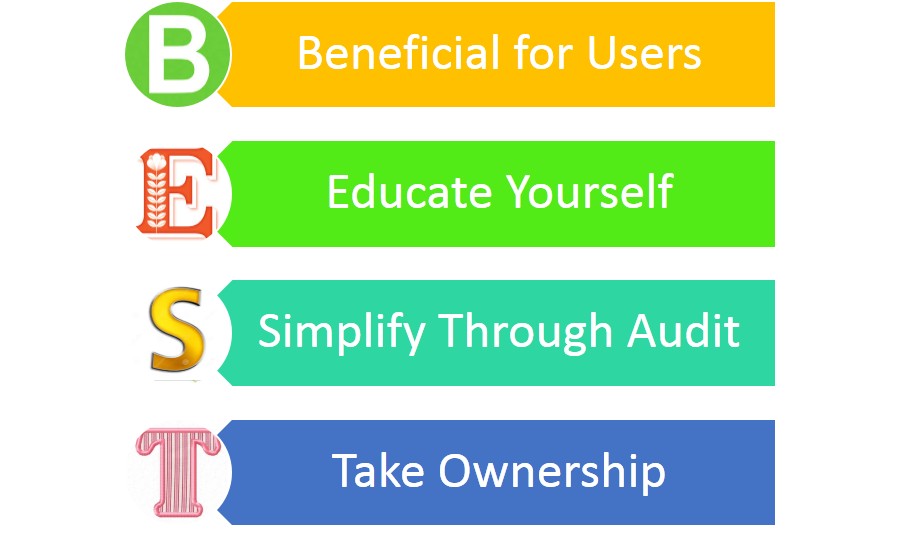“Content strategy plans for the creation, publication, and governance of useful, usable content (UX Booth, 2014).”

Image Source: Pixabay
Content on a website can originate starting from the menu text to body text, blog post text, news text, product related text and may even refer to images. Facebook content was mainly organised by developers, designers and product managers. The Facebook UX team realized the importance of organised content and created a new role titled “Content Strategist” since the UX team identified that users were confused and frustrated with the content provided (Halvorson, 2012).
Halvorson (2012) has suggested a few techniques where a website can be improved by following a few steps.
I’ll be using “BEST” to explain some of these steps to help content marketers plan and manage their activities in a more structured way.

Beneficial for Users – Do less, not more
The idea that more content means more business to the company is an improper practice and Halvorson (2012) suggests that having less content is more beneficial than having too much of content which can make users frustrated. Any content in a website should have usefulness to users and have a business objective. Hence, always prefer quality over quantity when it comes to creating digital content.
Educate Yourself – Learn how to listen
Content related issues occur mainly because no one in an organisation has asked the right questions related to content (Halvorson, 2012, p. 10). Listening to colleagues and users is an important part of educating yourself on the content rather than thinking that the answers are already known.
Colleagues – Since content is developed and maintained by colleagues it’s important to understand the processors and issues that occur (Halvorson, 2012, p. 10).
Users – “No one knows better what your customer needs than your customer (Halvorson, 2012).” Listening and receiving information from customers will make way in creating and updating content more efficiently.
Simplify Through Audit – Figure out what you have and where it’s coming from
Content on a website may exist regardless of the fact whether the content is useful for the business or not. Businesses may have a massive amount of content in the website and Halvorson (2012) suggests that an audit can be a tremendous first step and should be conducted in order to simplify the content.
Website owners conduct audits when there is migration of content in to a new content management system (CMS) but Halvorson suggest that audits should be carried out constantly.
Take Ownership – Put someone in charge
Most organisations have no idea on who’s in charge of content. When the question is asked on who owns the content the possible replies would be as follows (Halvorson, 2012).
- Lots of individuals.
- Just one individual who handle’s content request from others.
- No specific person or group.
Halvorson (2012) explains that the above three answers are a result of no one owning the content and that the situation is rather not in favor of the organisation.
Halvorson (2012) explains a solution in relating the content ownership role in relation to a print publishing business. As the editor-in-chief is in charge of the creation, deliverance and governance of content so must an individual or in a large organisation a group of individuals should be in charge of web content (Halvorson, 2012, pp. 11,12).
In this regard, social employee advocacy can also play a vital role in creating and distributing useful content.
Act Now!
“Fake it ’til you make it (Halvorson, 2012)”
The above statement implies that the starting point of reorganising content is the present moment regardless of the fact that if there is a budget or approval for the process. Halvorson (2012) suggests a few steps for content strategists which are mentioned below in order to start the process.
- Ask your boss – Request information on the website and which areas are not satisfying.
- Start asking specific questions – questions about content and who owns the content and the importance of the content.
- Educate yourself – get ready to defend suggestion by reading articles, listening to audio podcast, reading related books and participate in various forums.
- Take colleagues to coffee or lunch – communicate with colleagues and build trust and converse the importance of content. This would be a good method to listen to the ideas that colleagues have.
Still not sure how to develop a content strategy? We can help you out with a content strategy blueprint that best complements your business’s overall marketing objectives.
About solomoIT
SolomoIT is a boutique digital marketing agency based in Melbourne and Sydney since 2004. Our clients benefit from our years of experience in Digital Marketing. Our strategies are flexible and adaptable and we make sure our clients get the right message in front of the target audience with our expert guidance and holistic approach.
Are you ready to take your business to the digital era and “Think Digital”? Give us a call on 1300 430 949 or +613 8630 2810 for a consultation and we can help you take your business to the next level!
Related Posts
7 Reasons Why SME Businesses Must SURFACE In 2016 And Beyond
Businesses that have already surfaced to the cloud are aware of the massive efficiencies they are able to reap using web and mobile applications leveraging the latest digital hybrid technology hardware...
Why Getting a Responsive Website Presence is Only the START of the Journey?
In today digital age it is given that every business needs to have a web presence in order to reach their potential target market! However, Having assisted hundreds of small to medium businesses develop...
Twitter’s 140 Characters to Become MORE Intuitive for Brands
Officially announced! to the total length. That’s not all! This is a fabulous news for SMEs struggling to
